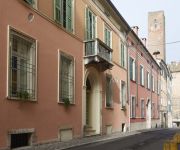Facts and Data
Webpages:
Official Unesco Page
Basis Data:
Unesco World heritage since: 2008
Size of heritage: 235 ha
- Buffer zone: 2,330 ha
Coordinates:
Longitude: 10,794°
Latitude: 45,159°
Summary
Mantua and Sabbioneta, in the Po valley, in the north of Italy, represent two aspects of Renaissance town planning: Mantua shows the renewal and extension of an existing city, while 30 km away, Sabbioneta represents the implementation of the period’s theories about planning the ideal city. Typically, Mantua’s layout is irregular with regular parts showing different stages of its growth since the Roman period and includes many medieval edifices among them an 11th century rotunda and a Baroque theatre. Sabbioneta, created in the second half of the 16th century under the rule of one person, Vespasiano Gonzaga Colonna, can be described as a single-period city and has a right angle grid layout. Both cities offer exceptional testimonies to the urban, architectural and artistic realizations of the Renaissance, linked through the visions and actions of the ruling Gonzaga family. The two towns are important for the value of their architecture and for their prominent role in the dissemination of Renaissance culture. The ideals of the Renaissance, fostered by the Gonzaga family, are present in the towns’ morphology and architecture.
Location on Map
Show bigger map on Openstreetmap
Introduction
Mantua and Sabbioneta, located in the Lombardy region of northern Italy, are two exceptional Renaissance cities that have been recognized as a UNESCO World Heritage site since 2008. These cities, with their rich history and architectural marvels, offer a glimpse into the cultural and artistic achievements of the Renaissance period.
History
Mantua, also known as Mantova, was founded by the Etruscans in the 6th century BC and later became a significant Roman city. It flourished under the Gonzaga family, who ruled over the city for nearly four centuries, from the 14th to the 18th century. The Gonzagas transformed Mantua into a cultural and artistic hub, attracting renowned artists and intellectuals.
Sabbioneta, on the other hand, was built from scratch in the late 16th century by Vespasiano Gonzaga, a member of the Gonzaga family and the Duke of Sabbioneta. Vespasiano aimed to create an ideal Renaissance city, and his vision resulted in the construction of a perfectly planned town with impressive architectural achievements.
Mantua: A Renaissance Gem
Mantua's historic center is a treasure trove of architectural wonders. The Palazzo Ducale, the former residence of the Gonzaga family, is a masterpiece of Renaissance architecture. Its stunning frescoes, grand courtyards, and opulent rooms reflect the wealth and power of the Gonzagas. The Palazzo Te, another architectural gem, is renowned for its magnificent frescoes by the renowned artist, Giulio Romano.
The city is also home to the Rotonda di San Lorenzo, a unique circular church dating back to the 11th century. Its striking design and beautiful interior make it a must-visit for art and architecture enthusiasts. Additionally, the Mantua Cathedral, with its impressive bell tower and intricate facade, showcases the city's religious heritage.
Sabbioneta: The Ideal Renaissance City
Sabbioneta, often referred to as the "Little Athens of Mantua," is a testament to Vespasiano Gonzaga's vision of a perfectly planned city. The town's layout, with its geometric precision and harmonious proportions, is a remarkable example of Renaissance urban planning.
The Palazzo Ducale in Sabbioneta, modeled after the Palazzo Ducale in Mantua, is a magnificent structure that houses a museum showcasing the city's history. The Teatro all'Antica, an ancient theater inspired by Roman amphitheaters, is a remarkable architectural achievement and still hosts performances today.
Current State
Mantua and Sabbioneta have been meticulously preserved, allowing visitors to experience the splendor of the Renaissance era. The cities' historic centers are well-maintained, and efforts have been made to protect and restore their architectural treasures.
Both cities continue to attract tourists from around the world who come to admire their architectural marvels, explore their rich history, and immerse themselves in the cultural heritage of the Renaissance. The annual Mantua Literature Festival, held in Mantua, further enhances the city's cultural significance.
Conclusion
Mantua and Sabbioneta, with their rich history, architectural wonders, and cultural significance, are truly remarkable UNESCO World Heritage sites. These cities offer a unique opportunity to step back in time and appreciate the achievements of the Renaissance period. Whether it's exploring the grand palaces, admiring the intricate frescoes, or simply strolling through the perfectly planned streets, a visit to Mantua and Sabbioneta is a journey into the heart of Renaissance Italy.
Hotels and places to stay
L'Hotel & La Residenza Broletto
Hotel dei Gonzaga
Ai Garibaldini
Residenza Cà Tazzoli
Accademia Residenza
Residence al Corso
Agora Residenza Apartments
Residenza Domus Nova
B&B Al Podestà
Residenza Romeo e Giulietta
Videos from the area
Videos provided by Youtube are under the copyright of their owners.
















